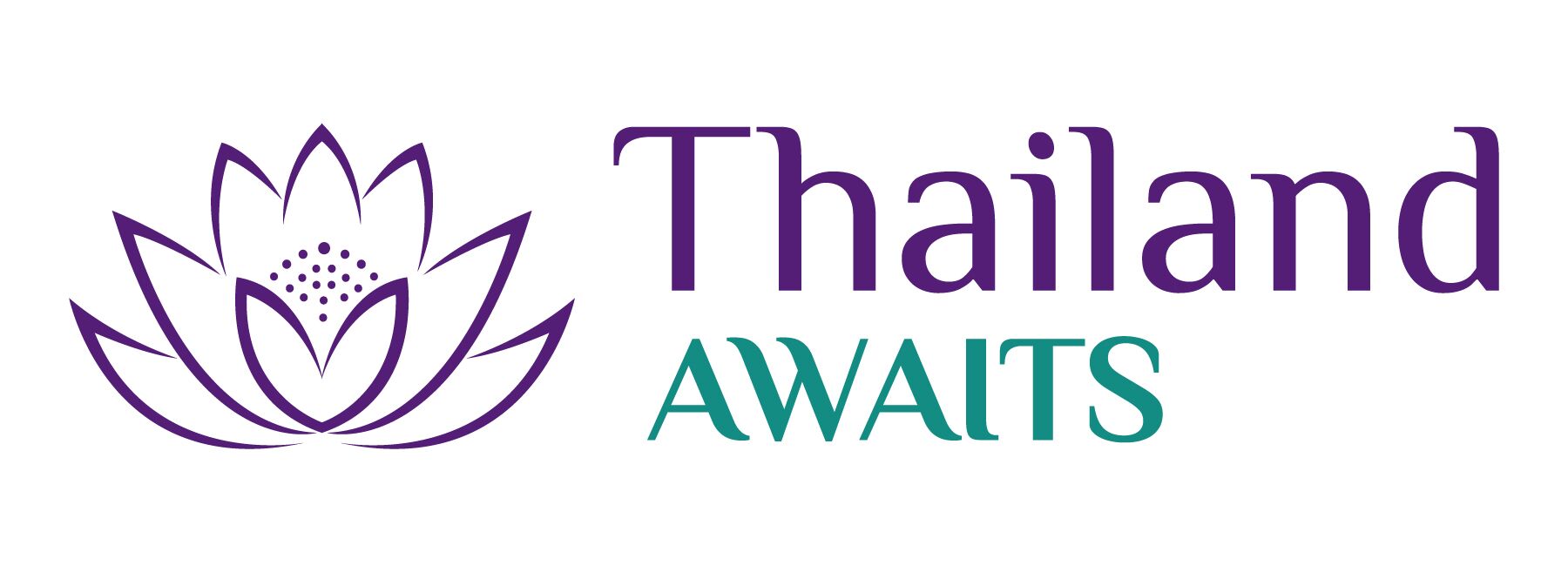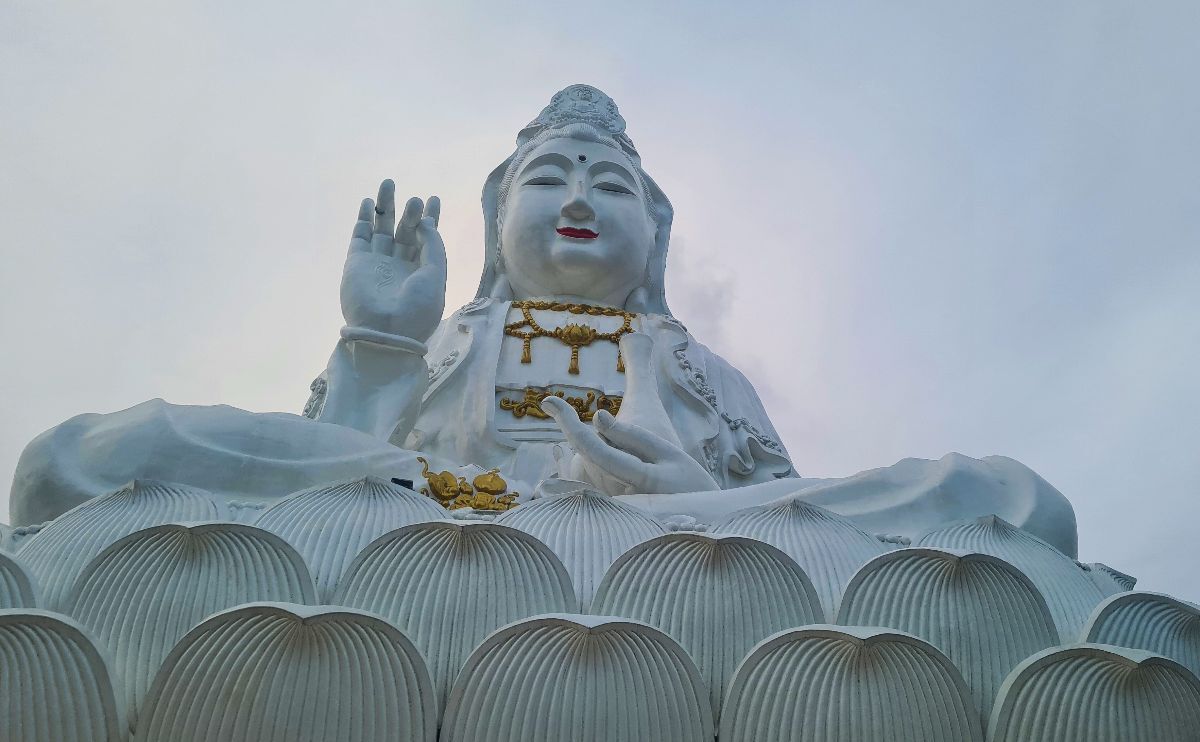One of the main reasons for heading north of Chiang Mai is to see the famous temples in Chiang Rai. The city certainly overdelivers when it comes to spectacular temples. Therefore, the best way to make sure you see as much as you possible in a couple of days is to decide which ones you want to see and sort out a bit of an itinerary for your visit.
It’s the famous White Temple and Blue Temple that draw most visitors north to Chiang Rai, but along with these impressive temples are there any others that should be on your list? I recently spent 48 hours in Chiang Rai, which, while a little rushed, was a good amount of time to enjoy the city’s temples and major sites before we moved further north.
In this guide I will share my top 5 temple sites in Chiang Ria I will tell you what makes each one special and add some practical tips that we picked up on our visit. I will also add some nearby sites you can include to mix things up a little.
This page contains affiliate links. Please see our disclosure policy for more details.
Making the most of your 48-Hour Itinerary in Chiang Rai
With so many captivating temples and many other holy sites and attractions to explore, it’s important to plan your visit carefully to make the most of your 48-hour trip to Chiang Rai. If you are unfamiliar with the specific temples scroll down for full details on each.
- For a successful temple tour, consider leaving Chiang Mai at dawn. Most tour buses won’t leave until 9am so this will give you a good head start on the crowds.
- It makes sense to begin with the best known site in Chiang Rai Province, the enchanting White Temple (Wat Rong Khun) as you make your way into town.
- Next up, see the blue-hued Wat Rong Suea Ten. It’s every bit as beautiful as the White Temple.
- Move on to the less known Wat Jed Yod and have lunch across the road at the little pad Thai stall.
- If you are travelling from Chiang Mai by land, these will take up most of your day. After that, head to the night market and see the clock tower light up in the evening.
- On your second day, head over to Wat Huay Pla Kang in the morning for the best light. Then, visit the historic Wat Phra Kaew in the afternoon. Visit Baan Dam in the middle of the day to add a twist to your temple tour.
Remember, the magic of Chiang Rai’s temples isn’t only in their beauty or historical significance, but also in their spiritual significance. As you explore these temples, take a moment to connect with the sacredness these holy sites still represent for many Thais.
Tips for visiting the temples in Chiang Rai
The best way to enjoy your time at these temples is to time your visit carefully. Many visitors come from Chaing Mai on day trips, meaning the crowd crush begins at about 11am. Try to visit in the early morning or later in the afternoon to avoid long lines.
Be sure to dress appropriately and cover knees and shoulders. While the rules are not as strictly enforced as they are in some places, this is still very important.
Resist any showy displays of affection or silly photo poses. Remember these are places of worship.
Temple opening hours
| Temple | Hours* |
|---|---|
| Wat Rong Khun (The White Temple) | 8am-5pm |
| Wat Rong Suea Ten (The Blue Temple) | 7am-8pm |
| Wat Huay Pla Kang (Goddess of Mercy) | 7am -9pm |
| Wat Phra Kaew (Temple of the Emerald Buddha) | 7am-6pm |
| Wat Jed Yod | 9.30am-6.30pm |
When and how long? Timing your temple visits
If you are wondering how much time you should allow for visiting the most famous temples in Chiang Rai, we found when planning our time in the city that it was best to prioritise these important sites and then add extra things to do in the city around them.
Tip: The gates of these temples generally open at 6:30am. This can be a great time to photograph them.
Choosing both the best time of day and figuring out how long to allow for each visit is personal. However, we generally
- Wat Rong Khun (White Temple) – Allocate at least 1 hour to appreciate the intricate details of this ethereal temple. The early morning light adds a silver glow to the already dazzling structure, making it a perfect backdrop for your photographs. If you can’t make sunrise, try to arrive before 10am or after 3pm to avoid the largest crowds.
- Wat Rong Suea Ten (Blue Temple) – With its stunning hues and vibrant atmosphere, we recommend approximately 30 minutes for the Blue Temple visit. This temple looks best in the early morning or the late afternoon and early evening when the colour is most vivid.
- Wat Huay Pla Kang (Goddess of Mercy) – best seen in the early morning or afternoon when the sun casts lovely golden shadows. Allow at least an hour for your visit. The light was spectacular and I found it hard to leave.
- Wat Phra Kaew (Temple of the Emerald Buddha) – Visit when the museum is open between 9am and 5pm so you can view the relics discovered here. Allow 30-60 minutes depending on whether you are interested in the museum.
- Wat Jed Yod – This temple opens a little later than the others. We visited it in the middle of the day while exploring the town centre and market. You won’t need more than 20-30 minutes here.
THe must See temples in Chiang Rai
I always think it’s good to know a little about a temple before you visit so here is my crash course in the five temples I think should be at the top of your list of things to see in Chiang Rai.
The Magnificent White Temple: Wat Rong Khun
The pièce de résistance of Chiang Rai, Wat Rong Khun, is more than just a temple. This snow-white marvel, designed by Thai artist Chalermchai Kositpipat, is an expression of Buddhist teachings intertwined with pop culture references.
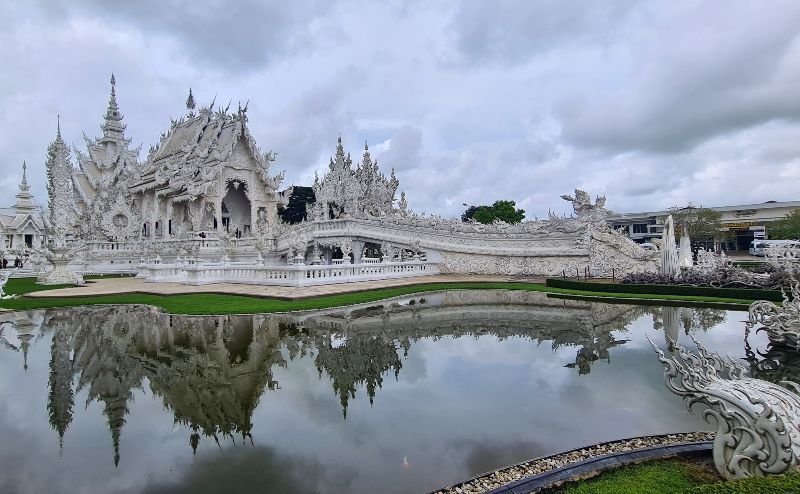
Chalermchai wanted to create a unique and unconventional temple that would stand out from traditional designs. He began work on the temple in 1997. It is considered one of the most beautiful and least conventional temples in Thailand.
Although a temple stood at this location for centuries, by the late 20th century it was in a state of pitiful disrepair. That’s when national artist Chalermchai Kositpipat, who was born in Chiang Rai, decided to entirely rebuild the temple using his own funds.
While the temple looks finished, construction is still ongoing. The artist envisions the project to be completed by 2070. His masterplan includes nine buildings – including the ubosot, the hall of relics, the hermitage and the art gallery.
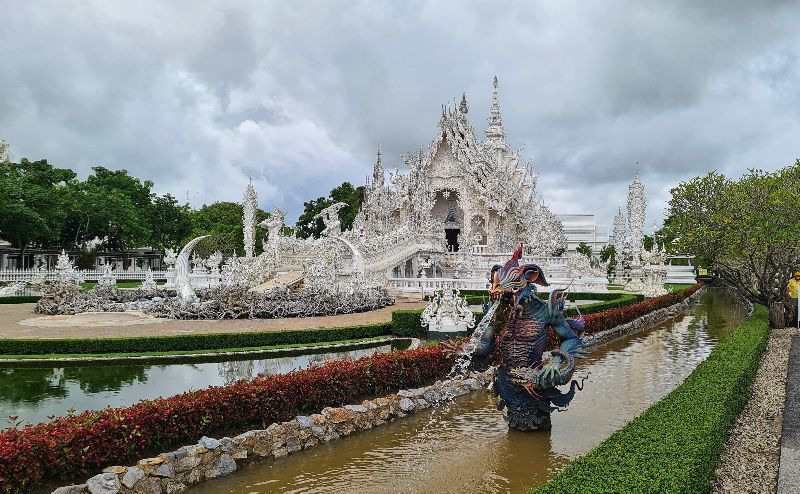
The temple is entirely white, symbolizing purity, and is adorned with intricate carvings and sparkling pieces of mirrored glass.
The final layout will comprise nine buildings, each embodying different elements of the Buddhist teaching.
Discovering the White Temple’s Unique Features
As you approach, you’ll cross a bridge over a pit of reaching hands—representing desire—and enter an ornate building signifying the realm of Buddha. Inside, expect the unexpected: murals depicting Elvis, Harry Potter, and even scenes from Star Wars intermingling with traditional Buddhist imagery.
- The Path of Virtue – The Bridge of “the Cycle of Rebirth”: As you approach the temple, the first thing you will notice is a grand bridge. It’s meant to symbolize the path of virtue and crossing it is equivalent to overcoming worldly desires and distractions, as per Buddhist beliefs.
- The Sea of Hands – “the Hell”: The bridge crosses over a pit filled with sculptures of desperate, outstretched hands, symbolising human suffering and hell. This dramatic scene might look eerie, but it delivers a powerful message about the crucial importance of moral and ethical actions.
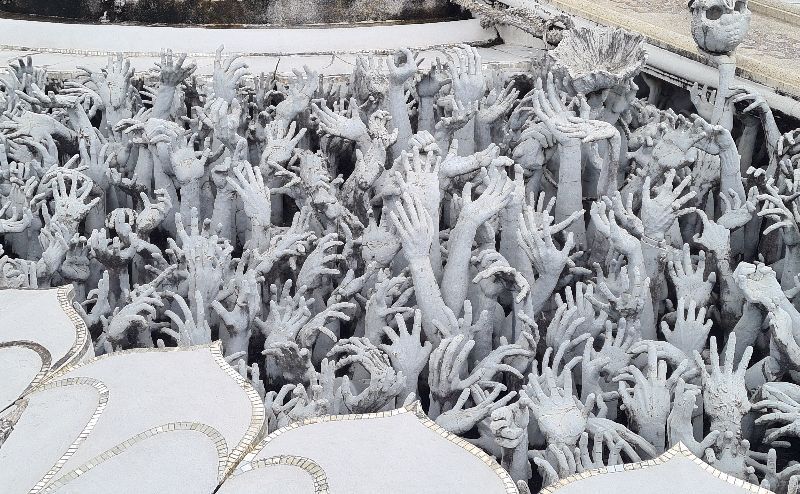
- Upon crossing the bridges, you enter the Main Temple Hall – “the Heaven”. The interior of the temple is beautifully serene, in stark contrast to the eeriness outside. Exquisite murals of Buddha, ornate carvings and calming hues dominate the interior. Here, you can stand in silent contemplation, absorbing the tranquility of the surroundings.
- The famous mural wall features various pop-culture identities. No, you are not hallucinating, these depict a complex web of good versus evil, heaven versus hell. It emphasises how our actions in this life will impact our afterlife, a core belief of Buddhism.
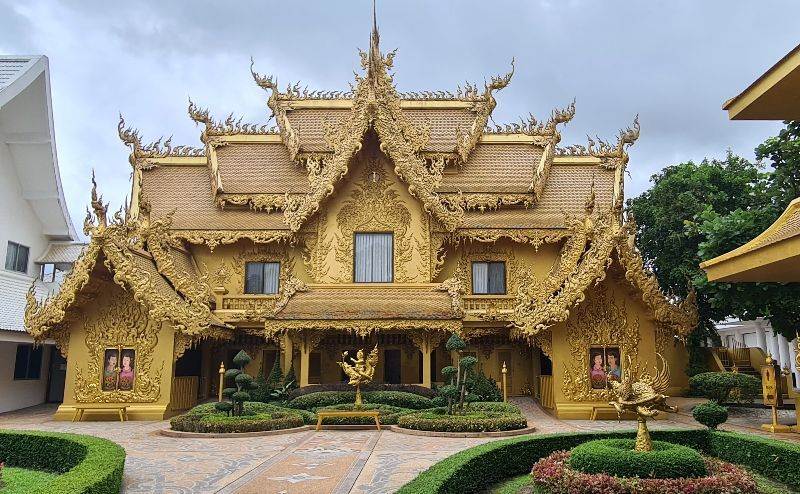
Before you leave, visit the Golden Structure. The golden structure nearby represents our worldly desires and attachments, contrasting the white temple. It is actually the toilet block!
Where: 1 Phahonyothin Rd, Pa O Don Chai, Mueang Chiang Rai District, Chiang Rai
The Enchanting Blue Temple: Wat Rong Suea Ten
The Blue Temple, officially known as Wat Rong Suea Ten, is another of the remarkable temples in Chiang Rai. It was designed by Putha Kabkaew, a former student of Chalermchai Kositpipat, and its construction was completed in 2016.
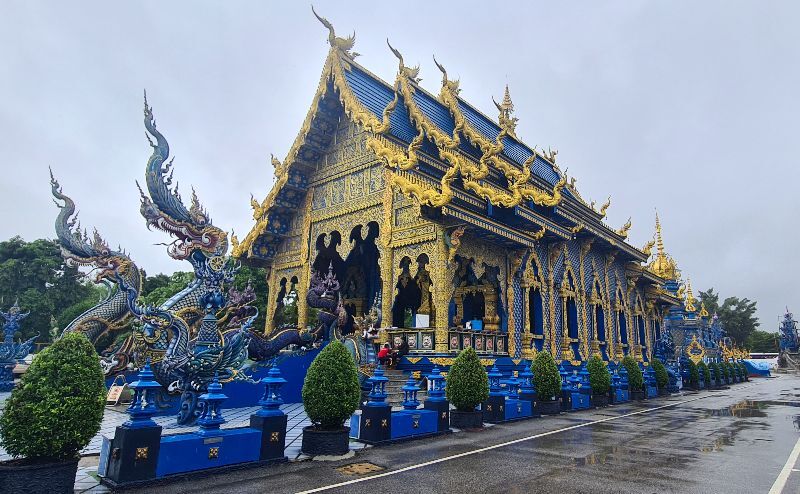
The temple’s name translates as the house of the dancing tiger, in a nod to the tigers who used to roam this part of Chiang Rai.
The building features stunning murals and intricate sculptures, the blue colour representing the Dharma.
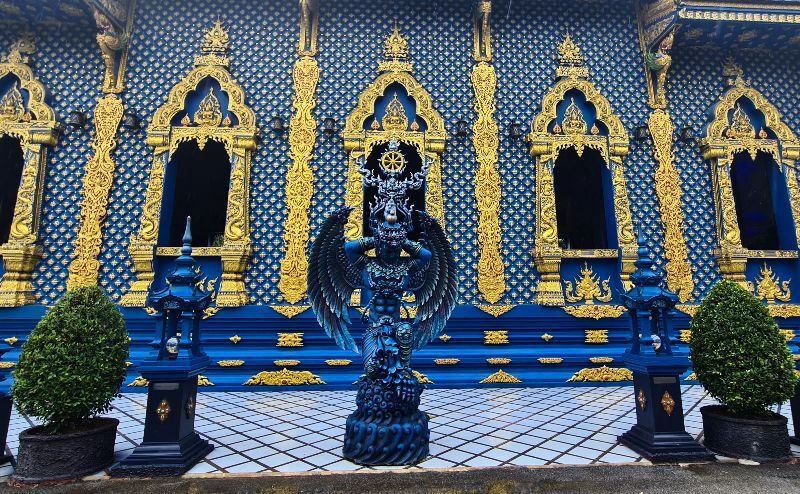
The Blue Temple was a secret jewel because it is relatively new and not as well-known as other temples in the region, but that is changing quickly. Its vibrant blue colour and exquisite artwork have made it a favorite on Instagram for people who visit Chiang Rai.
The temple compound does not follow a narrative or represent a philosophical journey like the White Temple. Its beauty lies in its architectural design and the peace it resonates.
Features of the Blue Temple
The interior of the temple is stunning. A grand white statue of Buddha poised in the Bhumisparsha Mudra pose stands inside. This positioning showcases Buddha’s right hand gesturing towards the earth, symbolising the very moment when enlightenment was achieved.
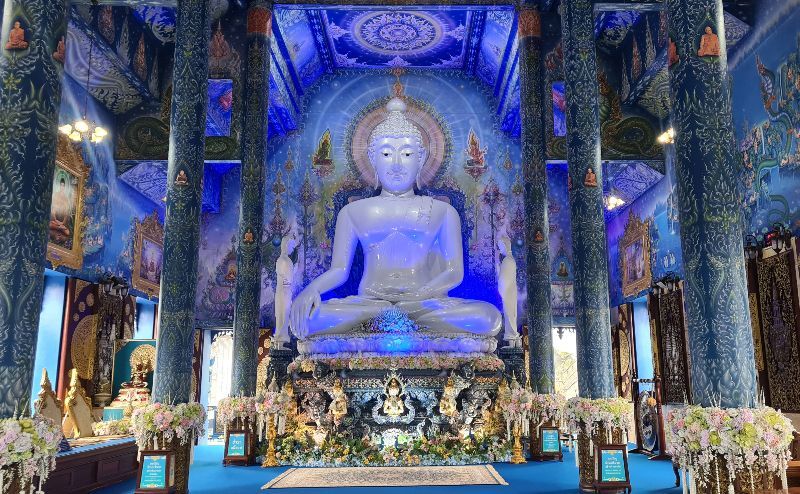
From afar, the Blue Temple looks like it is glowing in the dark because of its vibrant colour. This effect is more pronounced in the evening when it creates a breathtaking contrast against the twilight sky.
Take some time to walk around to the back of the temple and see if you can find these little Buddhas.
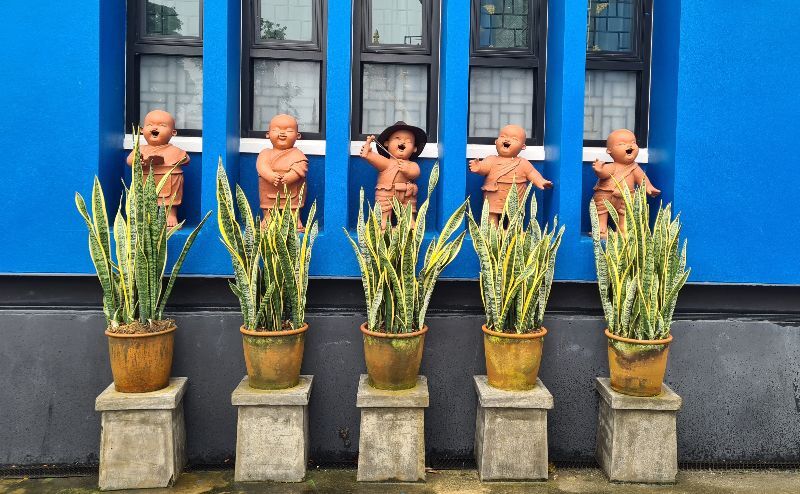
Where: 2 Maekok Rd, Tambon Rim Kok, Mueang Chiang Rai District, Chiang Rai
Wat Huay Pla Kang (Goddess of Mercy)
Wat Huay Pla Kang is perhaps most renowned for the colossal statue of Guanyin, the Goddess of Mercy. If you’re unsure about who Guanyin is, she’s a bodhisattva associated with compassion.
Here she is positioned atop a ceremonial dragon. At 78 metres, this is one of the largest statues of Guanyin in the world! Intricately carved dragon pillars lead the way up to the statue, adding to the architectural marvel of the site.
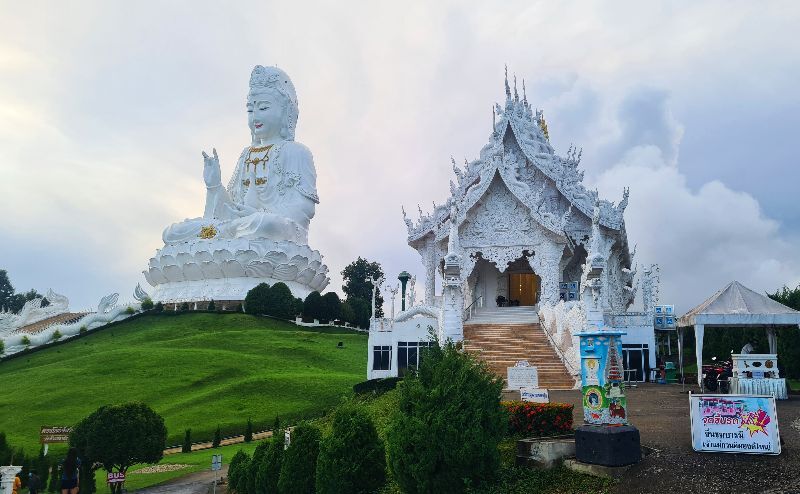
The temple offers scenic views over Chiang Rai, and at dawn and dusk skies paint a vivid backdrop to the majestic relay of the Goddess.
The temple offers scenic views over Chiang Rai, and at dawn and dusk, skies paint a vivid backdrop to the majestic display of the Goddess.
Once you see a photo of the breathtaking Wat Huay Pla Kang, it will make your list of places to visit. And it should.
After you have finished admiring from the outside, pay the small fee to visit the head of the statue 25 floors above.
Thankfully, you reach the 24th floor by elevator with just a few stairs to the top level. Looking out the windows on the top floor, I found myself surrounded by expansive views of the countryside as the light changed in the late afternoon.
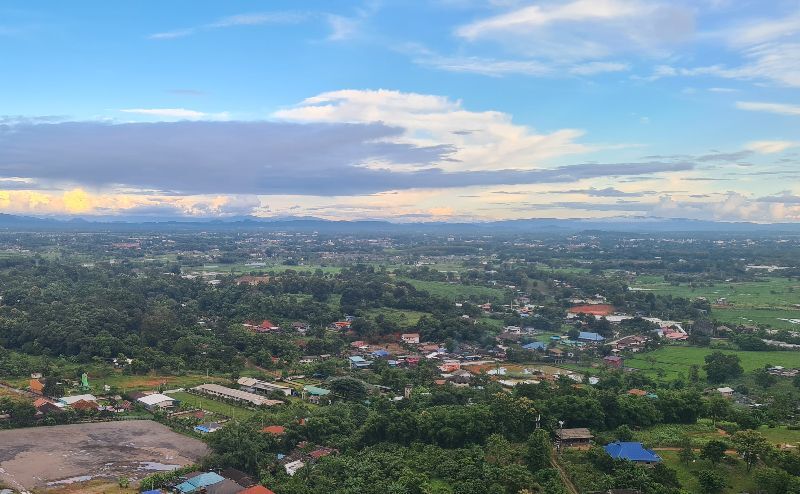
The top levels are adorned with finely crafted wooden statues of Buddha, monks, and other divine beings.
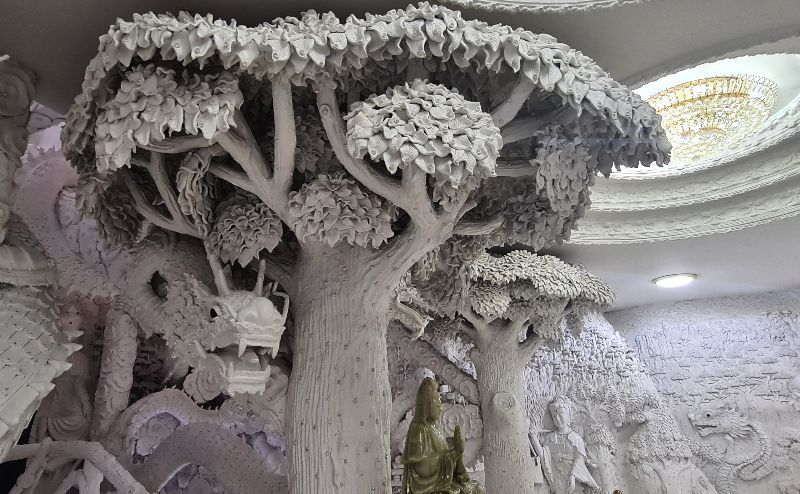
You won’t regret making time to explore the sprawling complex surrounding the Guanyin statue. It features a large golden Buddha, a dragon boat temple, and countless smaller structures and sculptures that are just as impressive.
Where: 3 Tambon Mae Yao, Mueang Chiang Rai District, Chiang Rai
Wat Phra Kaew (Temple of the Emerald Buddha)
Wat Phra Kaew, a significant temple steeped in a rich history that dates back to the 15th century, sits in the heart of Chiang Rai. It was here that the Emerald Buddha, Thailand’s most cherished religious artifact, was originally discovered.

The Emerald Buddha now resides in Wat Phra Kaew in Bangkok, but a replica has been thoughtfully placed in the original setting. This makes Wat Phra Kaew in Chiang Rai a truly authentic historical destination for visitors.
Where: 19 หมู่ที่ 1 Trairat Rd, Wiang, Mueang Chiang Rai
Wat Jed Yod
Unlike the extravagant designs seen at the Blue and White temples, Wat Jed Yod has a quiet charm with its simplistic Lanna architecture. Here, the main draw is not so much visual stimulation but a chance for serene contemplation.
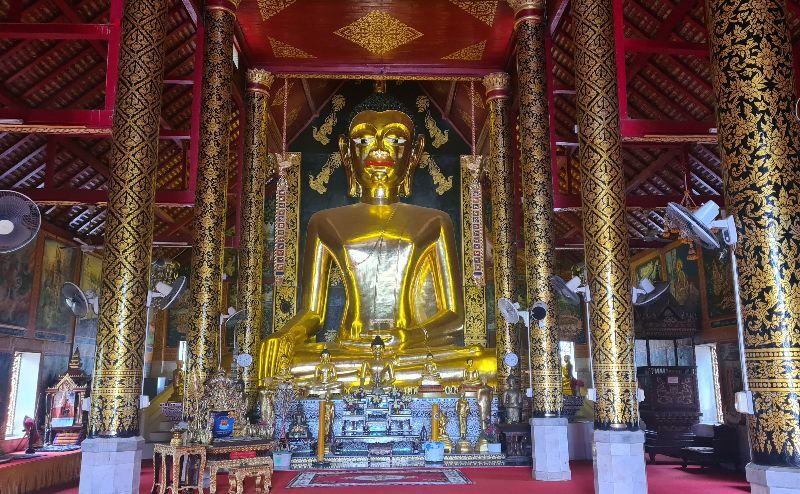
Inside the main viharn, you’ll find beautiful murals depicting stories from the Jataka, the collection of tales about Buddha’s previous births. If you arrive in the morning, you may see monks praying.
Tip: Visit at lunchtime and pop into Pad Thai Jet Yod across the road for one of the best Pad Thais of our trip.
Where: Tambon Wiang, Mueang Chiang Rai (closed Saturday)
Want more temples?
In both the city centre and surrounding countryside of Chiang Rai, there are dozens more temples, including:
- Wat Phra That Doi Tung to the north of Chiang Rai, offers panoramic views and is worth a detour if you are heading to the Golden Triangle or the famous rescue cave.
- Wat Tham Phra (Buddha Cave Temple) is a good choice if you have not seen a cave temple. Following the riverside path, you’ll find a large Buddha statue with views over the Kok River – a pleasant visit if you have time.
- Wat Phra That Doi Chom Thong on a hilltop overlooking the city, this temple offers breathtaking panoramic views of Chiang Rai. The temple is known for its golden chedi, which houses relics of the Buddha. Visitors can climb the stairs to the top of the chedi and enjoy the stunning vistas.
Attractions to visit near the temples
Indeed, the magic of Chiang Rai isn’t restricted solely to its sacred temples. By adding a few of the following experiences, you will avoid becoming tired of visiting temples and learn more about the diverse mix of cultures, traditions, and history that Chiang Rai represents.
The Remarkable Black House: Baan Dam
Some visitors think the Black House is a temple, but it is in fact an art museum! The Black House, known in Thai as Baan Dam, is a series of intriguing and slightly eerie constructions scattered across a lush garden, displaying a vast collection of animal relics and eccentric artwork.

The Black House art museum, the creation of renowned Thai artist Thawan Duchanee, stands in stark contrast to Chiang Rai’s ornate temples. Duchanee’s work often delves into darker, more mystical themes.
A visit here offers a refreshing break from the traditional sightseeing trail and a window into the unique mind of one of Thailand’s most celebrated artists.
The centerpiece of Baan Dam is a large wooden structure that resembles a temple, but the interior tells a different story, filled as it is with fascinating and sometimes disturbing objects such as snake skins, buffalo horns, and crocodile skins.
Exploring the vast array of structures across the grounds, you’ll discover a collection that spans decades and cultures, including antiques and sculptures from Thailand, Indonesia, Africa, and beyond.
Tip: Visit after the Blue Temple as it is in the same direction and a good site to see in the middle of the day as it is quite well shaded.
Singha Park
This expansive leisure park offers a mix of agriculture, adventure sports, and picture-perfect sights. It’s home to vast tea plantations and provides opportunities for zip lining, cycling, and even feeding cute, cuddly animals.

Be sure to visit the iconic Singha statue, an imposing figure that dominates the park’s landscape. This statue is the symbol of Singha Corporation, a well-known landmark that provides a perfect backdrop for your photos.
Apart from enjoying the scenic views, you may also take part in tea tasting sessions where you’ll learn about the finesse involved in appreciating the subtle nuances of tea, its flavours, and brewing methods.
Chiang Rai The Night Bazaar
Chiang Rai’s Night Bazaar is the perfect place to soak up the local culture with trinkets, textiles, and tantalising street food. It is special because of its vibrant array of authentic Thai crafts, live music performances, and a globally renowned food court offering exotic local delicacies.
The Golden Triangle
You will need an extra night in Chiang Rai or perhaps a stay a little further north to see the Golden Triangle, a region where the borders of Thailand, Laos, and Myanmar meet, once notorious for its opium production.

Now, it’s a spot of historic intrigue offering remarkable vistas along the Mekong River. Must-sees include the Hall of Opium complex and on the way the Thamluang Khunnam Nangnon National Park where the incredible cave rescue took place in 2018.
So what do you think? Will you visit Chiang Rai?
After exploring these incredible temples, you’ll understand why Chiang Rai is more than just a stopover on the way to the Golden Triangle. Each temple offers something unique, from the mind-bending artistry of Wat Rong Khun to the serene beauty of Wat Jed Yod.
While 48 hours might feel rushed, it’s enough time to see these five temples and get a taste of what makes Chiang Rai special. Just remember to start early, dress respectfully, and take moments to soak in the atmosphere beyond just snapping photos.
Don’t be surprised if you find you wish you stayed longer. There’s so much to discover in Chiang Rai, whether it’s a local market, one of the beautiful tea plantations or the stunning countryside. This city may be overshadowed by its bigger neighbor Chiang Mai, but for anyone who has a little more time you will find it’s an absolute star of Northern Thailand.
Planning a Thai adventure? Join our friendly Facebook community Thailand Awaits: Trip Planning for Beginners. Get expert advice from locals and experienced travellers, ask your questions, and discover how to make the most of your journey through Thailand.
Heading to Chiang Mai? Don’t miss these helpful articles:
- The most important Chiang Mai’s Temples
- The ultimate guide to Chiang Mai’s night markets
- Where to stay in Chiang Mai
- Discovering the waterfalls of Chiang Mai
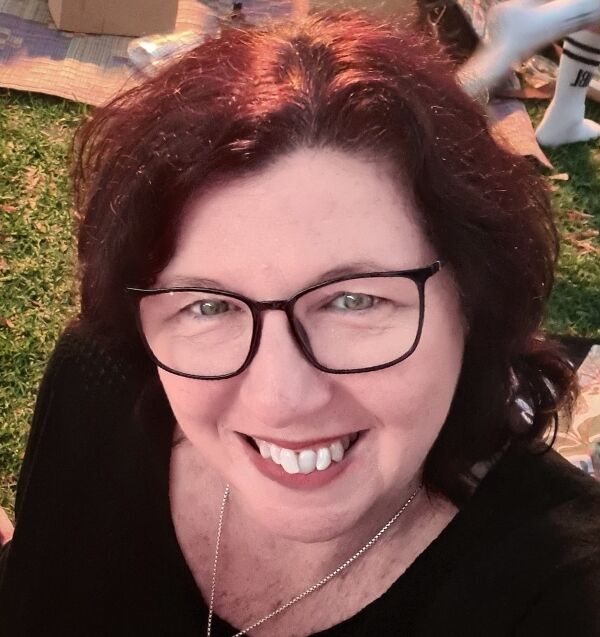
About the author: Paula Morgan first visited Thailand in 1999 and has been returning regularly ever since. She loves exploring its less visited spots, not just the iconic landmarks and historic temples, but the family run cafes and food stalls and the small communities in the islands of the south and the lush forests and mountains of Thailand’s north.
